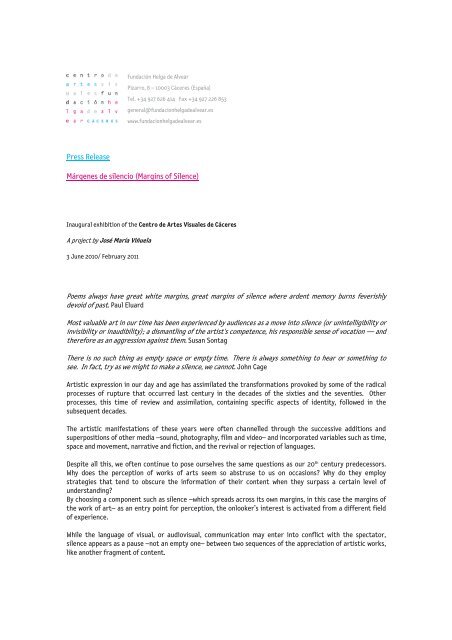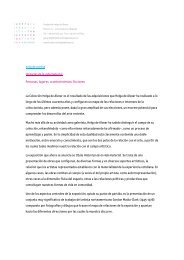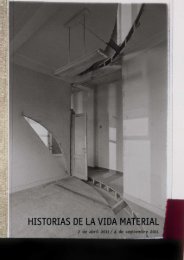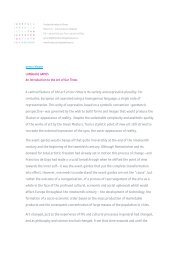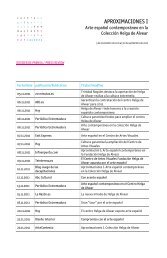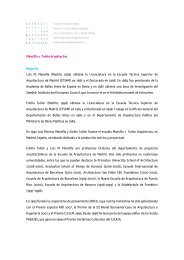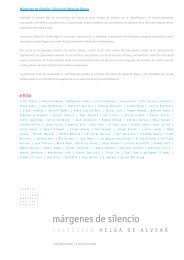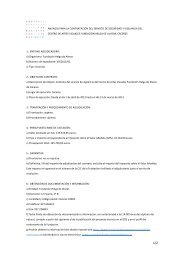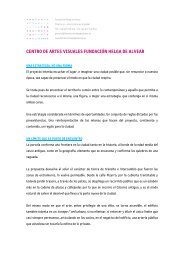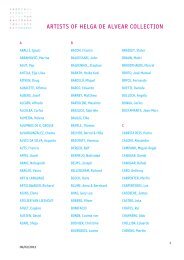Press release - Fundación Helga de Alvear
Press release - Fundación Helga de Alvear
Press release - Fundación Helga de Alvear
Create successful ePaper yourself
Turn your PDF publications into a flip-book with our unique Google optimized e-Paper software.
<strong>Press</strong> Release<br />
Márgenes <strong>de</strong> silencio (Margins of Silence)<br />
Inaugural exhibition of the Centro <strong>de</strong> Artes Visuales <strong>de</strong> Cáceres<br />
A project by José María Viñuela<br />
3 June 2010/ February 2011<br />
<strong>Fundación</strong> <strong>Helga</strong> <strong>de</strong> <strong>Alvear</strong><br />
Pizarro, 8 – 10003 Cáceres (España)<br />
Tel. +34 927 626 414 Fax +34 927 226 853<br />
general@fundacionhelga<strong>de</strong>alvear.es<br />
www.fundacionhelga<strong>de</strong>alvear.es<br />
Poems always have great white margins, great margins of silence where ar<strong>de</strong>nt memory burns feverishly<br />
<strong>de</strong>void of past. Paul Eluard<br />
Most valuable art in our time has been experienced by audiences as a move into silence (or unintelligibility or<br />
invisibility or inaudibility); a dismantling of the artist's competence, his responsible sense of vocation — and<br />
therefore as an aggression against them. Susan Sontag<br />
There is no such thing as empty space or empty time. There is always something to hear or something to<br />
see. In fact, try as we might to make a silence, we cannot. John Cage<br />
Artistic expression in our day and age has assimilated the transformations provoked by some of the radical<br />
processes of rupture that occurred last century in the <strong>de</strong>ca<strong>de</strong>s of the sixties and the seventies. Other<br />
processes, this time of review and assimilation, containing specific aspects of i<strong>de</strong>ntity, followed in the<br />
subsequent <strong>de</strong>ca<strong>de</strong>s.<br />
The artistic manifestations of these years were often channelled through the successive additions and<br />
superpositions of other media –sound, photography, film and vi<strong>de</strong>o– and incorporated variables such as time,<br />
space and movement, narrative and fiction, and the revival or rejection of languages.<br />
Despite all this, we often continue to pose ourselves the same questions as our 20 th century pre<strong>de</strong>cessors.<br />
Why does the perception of works of arts seem so abstruse to us on occasions? Why do they employ<br />
strategies that tend to obscure the information of their content when they surpass a certain level of<br />
un<strong>de</strong>rstanding?<br />
By choosing a component such as silence –which spreads across its own margins, in this case the margins of<br />
the work of art– as an entry point for perception, the onlooker’s interest is activated from a different field<br />
of experience.<br />
While the language of visual, or audiovisual, communication may enter into conflict with the spectator,<br />
silence appears as a pause –not an empty one– between two sequences of the appreciation of artistic works,<br />
like another fragment of content.
The body of works on display in the exhibition presented here have been chosen because they illustrate, in a<br />
wi<strong>de</strong>-ranging and approximate way, some of the concepts related to silence, and to the trail of changes these<br />
i<strong>de</strong>as have had on the attitu<strong>de</strong>s of artists since the sixties last century.<br />
The “margins of silence” symbolically encloses, therefore, the permeability of a specific place. A<br />
permeability that must flow in or<strong>de</strong>r to enable the dialogue with these works to attain the required level of<br />
intensity in each particular case.<br />
On display in this exhibition are works by many artists that form part of the history of art and have<br />
signposted some of the most frequented routes in its <strong>de</strong>velopment over the past five <strong>de</strong>ca<strong>de</strong>s.<br />
Also on display are works by younger artists who have been very active, though not in the mainstream, in<br />
creating their own unclassifiable languages.<br />
The first exhibition to be held at the Centro <strong>de</strong> Artes Visuales <strong>de</strong> Cáceres en<strong>de</strong>avours to convey the range of<br />
crucial moments for the <strong>de</strong>velopment of recent art encompassed by the Collection and the singularity of the<br />
works of art, i<strong>de</strong>as, methods and techniques that converge in it to build its appeal.<br />
In addition, the current selection faithfully reflects the evolution of <strong>Helga</strong> <strong>de</strong> <strong>Alvear</strong>’s artistic concerns and<br />
the affinities she has <strong>de</strong>veloped as her experience has grown in a field where one needs to be receptive and<br />
constantly alert.<br />
In this show the works on display are going to converse with the space and also with each other in a threepart<br />
interplay, thus allowing the artistic experience to achieve its full expressive potential.


